Napalm Beach at Bumbershoot 1985
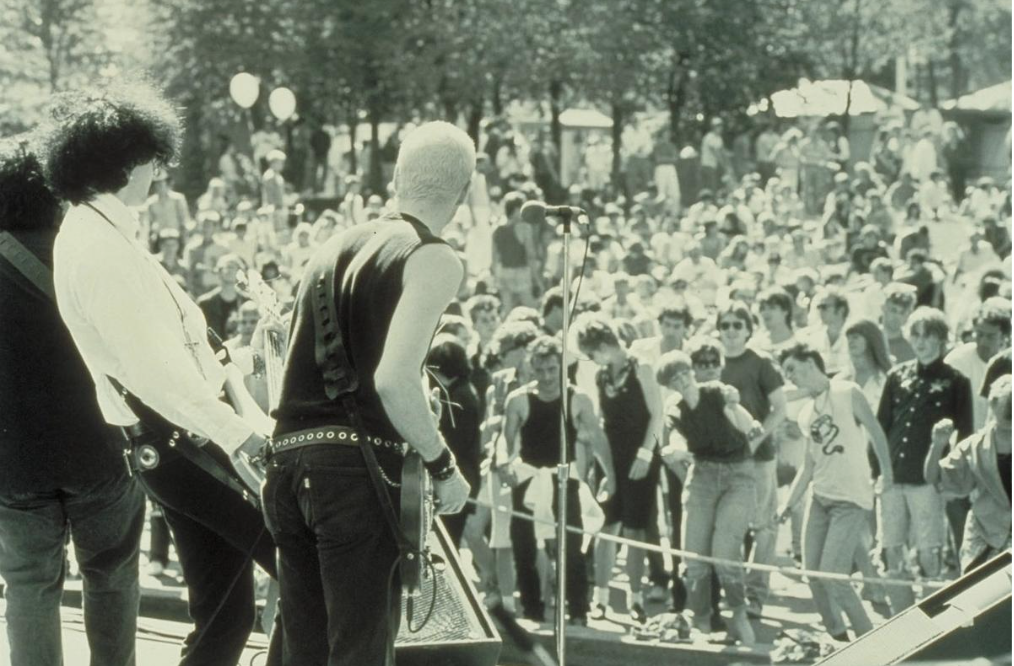
print available for purchase from Seattle Office of Arts and Culture
Napalm Beach, Snow Bud and the Flower People, Divining Rods, Boo Frog

In 1981, with income of about $800 a month from a trust fund set up by her maternal grandfather, Courtney moved into the first of many co-ed houses with struggling artists and rock performers. She promptly developed a crush on the lead singer of a group called Napalm Beach. From her earliest days, the objects of her affection have almost always been the breed that sings.
Hank Harrison, who had essentially been awakened from the dead, made up for the years he and Courtney had lost. He made good on his offer to put her up in Ireland, and several people who knew Courtney at the time say that she showed up with a thousand hits of very strong L.S.D.
– Melissa Rossi, Courtney Love: Queen of Noise p 33-34
Why was I not good enough to save you from destruction?
Your end and my beginning – Oh, they need no introduction– Courtney Love, “Honey”
I’m not sure when it first occurred to me that Courtney Love was a honey trap. I think it was sometime in 2019 and I’ll get to why. It is interesting though, that the first time I recognized that Courtney may have been trying to communicate to Chris via song was in her song “Honey.” And I strongly suspect now that the word “honey” – including the way it is used in A.A. Milne’s Winnie The Pooh books, and likely also in the band name Mudhoney. Mudhoney took their name from a 1965 Russ Meyer film I don’t recall seeing but also may be linked to the idea of a honey trap. I suspect that in the song “Honey” Courtney is admitting that she was used – by the FBI/CIA – as a honeytrap both for Chris Newman and for Kurt Cobain.
In 2013 I showed our music attorney a recording of “Honey” and I said I thought it contained a message to Chris. The attorney blew me off. He had massive conflicts of interest, and for this reason, in his dealings with Chris and me, was committing malpractice.
This is the recording I showed him:
The word “gutter” by the way appears to also have an underlying meaning, which is linked to “pins” and “spikes” – it references a radio frequency implant that is covertly placed into a person’s food which allows the gut and internal organs to be targeted with ultrasonic and other frequency-based weapons. In Chris’ case, his gut and gall bladder were among the organs which were attacked with cancer-causing frequencies. Similarly, my maternal grandfather was killed with stomach cancer in 1980. Everyone around me seems to have at least one implant in their gut. The CIA, FBI, and associated gangsters are behind this.
The reason why I am tending to fold the FBI and CIA into a single entity is because the CIA is, by law, not permitted to conduct operations – certainly not this type of operation – in the United States, against US citizens. So they are doing so under protection of the FBI, which is the one US agency that I know of which is linked both to intelligence activities and to the Justice Department (policing). The crimes I’ve experienced and witnessed are so heinous – and OBVIOUS – that I’ve tried to report them numerous times to police and FBI and so by now it’s beyond clear that the FBI is involved in, and covering up these crimes, and it is increasingly clear that they are doing this on behalf of the CIA as well as corporate entities.
One of the things the CIA/FBI has been doing is engaging in, and shepherding an older occult practice of child enslavement and covert trafficking sometimes called trauma-based mind control. My own family – both my mother’s side and my father’s side – have also been involved in this, both as victims and as handlers. This practice appears to run in families, and it seems to also have been part of Courtney’s family, on both her mother and father’s side. Without getting into detail right now, there are things that tell me this is the case. Furthermore, Kurt Cobain was in the same situation, at least on his mother’s side of the family. And Chris Newman as well, at least on his father’s side. The CIA/FBI seems to have been actively involved in cementing this system through systematic psychological warfare and use of these frequency based weapons which operate through the use of ground-based antennas, hand held weapons, and networks of drones which are difficult, but definitely not impossible, to see and photograph. I’ve got tons of photos of these aircraft, but the FAA is also participating in this cover up, as is the FCC so as long as the cover ups and omerta is intact, what can be done about it?
If you look up the definition of “honey trap” online, you learn that, at least in theory, a honey trap is supposed to collect intelligence information from their target – evidence and secret plans and so forth. This is not really how honey traps have been used with Chris and I – never mind that Chris and I were both artists, not foreign diplomats, military officers, or spies. With us, honeytraps have been used mostly for misdirection, subversion, and trafficking. Sure, the honey traps might report on us, but there’s no reason to suspect they were reporting accurate information. Likely they were paid to waste our time and sabotage us in different ways. In the case of Courtney, she was for Chris, for lack of a better word, jailbait. And this is why I first realized that she was a honey trap. Because I too, was sent jailbait. Not only that, but both Courtney and the young man who was sent after me were, in the late 1980s, connected to the same woman – Erika Schlaeger Dos Santos of Minneapolis, Minnesota.
I am not suggesting that Erika Schlaeger (I’ll use her maiden name from here) was behind the honeytrapping – just that she herself was part of the same child trafficking network.
I met Erika Schlaeger in northern Minnesota in the fall of 1985. Without getting into details, I am certain that I met her because I was meant to meet her. We quickly became friends, both having the same first name and feeling like outsiders. I left Minnesota the following spring, but ended up being funneled back to Minnesota in August 1987, where I quickly hooked up again with Erika Schlaeger who was then living in an artist warehouse space in downtown Minneapolis, the Berman Buckskin Warehouse. I went to school in Minneapolis for a while, then left in October 1989.
Erika Schlaeger hung out with artists, poets, and people in bands. I knew she was friends with girls in a band called Babes In Toyland that she thought was cool, but I didn’t know much more than that. She may have played me a tape, and I probably thought it was sludge and didn’t give it much thought. The so-called kinderwhore look was a thing back then – a lot of punk girls had that look – babygirl barrettes and girly dresses. It wasn’t really my thing.
I later learned from Erika Schlaeger that she also knew Courtney Love. She said that Courtney had almost moved into her warehouse space, but then decided to stay with Kat Bjelland instead. Trying to piece together exactly when this was, I concluded based on recent interviews, it was 1988. In other words, when I was living in Minneapolis and in regular contact with Erika Schlaeger.
A Minneapolis Star Tribune blog from 2010 quotes Courtney as saying she lived in Minneapolis three years “(’87-’89)” – but I seriously doubt that. I’m the one that lived in Minneapolis (and St Paul) – for two years – August 87-October 89. I suspect that Courtney was in Minneapolis for less than a year, in 1988. But I don’t know, because she moved around a lot and stories conflict.
I felt, even before meeting Chris, that Courtney was some kind of shadow person in my life, living in the SF Bay Area when my parents lived there, then in rural Oregon when I lived in rural Humboldt County, then in Portland and Minneapolis and Seattle – all places linked to me, some before she was there, some after. I even started having dreams about her, beginning in 2002. When Chris mentioned his connection to her to me in 2009, it was like it was just more of the same thing.
From June 1988 to October 1989 I lived in an apartment on University Ave in Dinkeytown, near the University of Minnesota. We used to hang out at a neighborhood coffeeshop called Giocco’s.
Sometime in late 1988 or early 1989, at Giocco’s, Erika Schlager introduced me to a young black boy – supposedly only 15 years old – who apparently was on his own, homeless. In my journals I call him “George.” I can’t remember if that was his real name or a name I made up. I wrote in an entry dated May 30, 1989 about my last meeting with George, where we walked down to the old Pillsbury Mill on the Mississippi river and he showed me the scar on his abdomen he said was from a bullet where his father shot him. “He was trying to shoot my mother but I got in the way of the bullet,” he told me.
For various reasons, I suspect the little boy in the 2018 film called Proud Mary was based on “George” and that the female assassin character who cares for him is a combination of Erika Schlaeger and my Dinkytown roommate at the time. And I suspect the older song called Proud Mary was based on the name of one of Chris’ ancestors, Mary Proude, wife of Isaac Pennington and mother-in-law to William Penn.
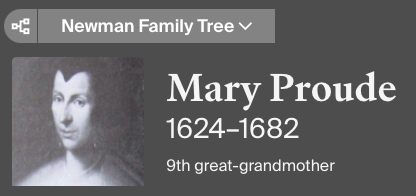
Anyway, when I first met George, I was 20 years old and he said he was 15 – the same age difference, incidentally, as between Mike Payne (also a honey trap) and me, when we met (I was 16 and he was 21). And 15 year old George was always putting the moves on me. He wanted me to be his girlfriend. It was probably after I’d seen the movie Proud Mary, and I started remembering George, and seeing the parallels between him offering himself to me, and Courtney offering herself to Chris, that I realized that this wasn’t likely just something that happened – it was a situation that was manufactured by someone in the background. And it was no doubt manufactured in the hopes of trapping us in order to smear us. I am certain that there were hidden cameras ready and eager to capture – and traffic – any misstep that might happen.
Erika Schlaeger is the one who introduced me to George, and was closer to him than me – seemed to take on a maternal role with him. He may have even stayed at her warehouse space. I don’t know where she met him, or whether they continued to stay in touch. On our last meeting, this was the conversation we had, which I put into my journal:
George: I won’t be seeing you no more… cause I’m going on a car trip across the United States.
Me: Who are you going on a car trip with?
George: These two girls.
Me: I’ll miss you.
George: No you won’t.
Me: Why not?
George: Because I’m taking you with me.
Chris began to compose a memoir. He wrote regularly during 2013, and stopped abruptly in January 2014 after I was chased down and kidnapped – aggravated kidnapping, I now realize, by a group that included the FBI/CIA as well as people linked to the entertainment industry – and held under the most outrageous false pretenses in a psychiatric mind control facility. Chris didn’t know what to make of all this, and he too was being subject to intense mind control techniques. I feel terrible that this instigated crash destroyed our band (the destruction was deliberate), our marriage plans (also a deliberate destruction), and ultimately, Chris’ last hopes of success (aggravated murder – these were crimes committed in order to facilitate and cover up other crimes).
However, by the time he stopped writing, Chris had recorded a lot of memories. The memoir draft is more focused on personal memories than on his music career, but music was intertwined throughout Chris’ life, as natural to him as breathing.
Chris did intend to publish this memoir, at least at first. Later he had second thoughts, but really what he needed was a good editor. Just as with everything else in his life, his work could have shone with a little professional assistance. This was not going to happen, however, as long as we were under the all-encompassing suffocating blacklist.
Chris’ memories of Courtney Love were important to him, and influenced his views on the possibilities of success in music. Courtney made Chris believe she was in love with him, or at least had a huge crush on him. When she went to Europe in 1981, she wrote him what he described as “love letters” – all of which were removed from his apartment and presumably destroyed in 1997 by his landlord and brother in law, even though the rent had been paid. Similarly, important letters from my collection to me have also gone missing, throughout the 1990s and even as recently as 2018 – including a copy of a 1983 letter to my grandmother about punk rock and the idea of having a music career that Kurt Cobain appears to have seen and quoted from – verbatim – in interviews. This is the sort of thing I mean when I talk about patterns.
Following is what Chris wrote about Courtney Love in the draft of his memoir. The only editing I have done is minor grammatical corrections (and added some relevant images).
We were soon blessed with a self appointed roadie. It was the night of the Joan Jett gig and Steve Shades pulled up his truck to the loading dock and yelled “Let’s go!” Steve was loud, obnoxious, and everybody in the Biz knew him and his loud mouth. He was a stage hand at big concerts, and his obnoxious behavior got him noticed all the time. It got him in trouble most of the time. It was as though Steve suffered from Tourette’s Syndrome.
Once he had to stand outside the cafe as we all enjoyed our after show dinners. Steve was asked to leave since he couldn’t seem to stop swearing. He always pretended to brag about his band The Shades. He briefly led the band playing bass, writing the songs, and calling the shots as Chelsea Ray handled the vocals. She appeared in the Kurt and Courtney documentary as the friend of the Cobain’s nanny, who seemed to be frightened for her life. She implied that Courtney was a dangerous woman.
Steve Shades ended up renting a house in southeast Portland. We all moved in, including a couple of extra room mates. One room mate being Courtney Menely. Later she became known as Courtney Love. Chelsea Ray happened to live right next door with her then husband and daughter. In 1982 Courtney was a trust fund baby. Maybe sixteen years old. She was usually loud and opinionated and always hyper. Courtney would climb in the van uninvited and ride to our Seattle gigs.
Her best friend Robin was a real looker and she and Courtney saw Napalm Beach with April Wine at the Paramount the year before. Courtney was a trippy Rocker chick. Her dad sent her a shitload of original Owsley Acid. Different colored barrels of pure LSD.
Axomoxa was a cool looking and sounding album by the Grateful Dead. Much more accessible than the first one (Morning Dew was my favorite cut) and the second, Anthem for the Sun. My Granny let me pick it out on my fifteenth birthday that summer in Longview. On the back cover a family of hippies are shown laying around on a grassy hill on a sunny day. Courtney Love claimed it was her as a child in the foreground. She claimed her father had dosed her with LSD at the age of four. She said he was the Grateful Dead’s manager of some type. Photographer, gopher, drug runner? She showed me the book he, Hank Harrison had published. It was something like, “My Life with the Dead.” It was all for real. Courtney was some kind of connected rocker kid from the very beginning.
When I watch Courtney’s father in the documentary Kurt and Courtney, I feel a seething hate for the man. He comes off as the opportunistic money-grubbing bitch that some claim Courtney to be. It breaks my heart to see a parent treat their child as disposable commodity. I respect the girl for her intelligence and tenacity. Courtney is as resilient as I am, but I know she hurts down deep.
Courtney had a different outlook back then. She was still developing into a woman and she was a rowdy and aggressive little tom boy sometimes. Other times she was a soft little feral kitten that only required love and understanding. She has so much intelligence and drive. The woman eventually became a household name and a glamorous celebrity in Hollywood. She was raised in a hippy commune and ended up in Beverly Hills.
Courtney has proven to be a pioneer in feminist music and values, yet she seems to hold onto old fashioned beliefs that it is a woman’s duty to take care of her man. She also strongly believes in the institution of marriage, at least it appears that way to me.
When Courtney visited Portland right after being in the movie, Sid and Nancy, she strolled through the Satyricon and walked past my table where I sat with my girl at the time, Nancy Loeffler, and proclaimed,”I would have married you Chris Newman!” I didn’t know what to say, but she kept walking, and out the door and into the night, she went.
She showed up at Nancy’s fancy apartment after hours. Ms. Love wasn’t getting anywhere acting like a Hollywood star, so she came down to our level, and we all included her in the cocaine-fueled conversations that late night.
The acid Courtney’s dad sent her was really amazing. It was as potent as the day it was manufactured, ten years before. We all tripped hard on that shit.
Me and Mark Nelson dropped acid together several different times.
Courtney gave a lot away and sold a few hits for $2.00. Courtney was pretty fun to hang out with as a young girl. One day I saw her diary sitting on her bed. I opened it to the most recent entry: I am in love with this musical genius named Chris, but he’s really fat, and I don’t know what people will think.
It angered me slightly, but I was so accustomed to that attitude. Fat guys rarely got the girl they wanted. I always set my sights high. I could sometimes charm a girl into ignoring my flaws and dazzle her with my shining brightness. Times did eventually change attitudes somewhat, especially as a woman gets more mature, she may fall for an overweight but exceptional guy. Men aren’t so forgiving about the shortcomings in a girl’s physical appearance. They say men are visually oriented and pursue that “trophy girl.” It is a sign of success in most circles.
Courtney did try to hook up with me. We had one evening alone in the band house. We made out on the rug in the light of the television. I stopped myself, after getting very intimate with her. She knew how to kiss back then. We just made out and fondled each other like teen-agers, only I was twenty eight and she was around seventeen. She told me she was a virgin, and she wanted her first to be me. I was thankful I didn’t carry out her request. I really liked Courtney, but she was a handful.
I never dreamed I would ever hook up with a loud aggressive woman, but I did end up marrying Valarie for fifteen long and exciting years.
When Courtney became famous, she had no qualms about “kissing and telling.” She often emasculated former lovers in the press. Calling them a lousy lay or less than adequate in the bedroom.
I was very impressed with HOLE’s album Live Through This which was released to critical acclaim in 1994 right after the suicide death of her famous husband.
My first wife, Valarie and I saw Courtney at La Luna in Portland. She had just been on the cover of Rolling Stone magazine. I got us in on the guest list and the guy at the door said, “Hey, Courtney was just taking about you.” I was in awe of her new found power and celebrity.
She quipped, “Hello, Chris Newman” from the stage.
I was high as fuck on heroin and I was beaming with pride. The entire concert blended together into a warm swirling embrace. I loved what I was experiencing. I felt there was a chance for me to make it in the music business.
In his 2021 book, The Rocky Road To Recovery: The Life of Chris Newman of Napalm Beach Eric Danielson claimed that Chris Newman “attended and participated in the infamous Satyricon Riot” (p 77, 171). This claim is uncited, unsupported, and false. I am not claiming that Danielson has deliberately falsified information. It’s possible this was a rumor that everyone had simply accepted as self-evident.
The Satyricon Riot of April 28-29 1990 is an event that has come up in conversation and in the press from time to time, ever since I moved to Portland in the summer of 2000. At some point in the early 2000s I conducted an interview with Satyricon owner George Touhouliotis who cited that event as being a turning point in his enthusiasm for running the club. What I didn’t understand, until researching the event in The Oregonian archives a few days ago, is that it really was not a one-night affair – but that it seems to have inspired a long running conflict involving not just a few criminal cases, but civil lawsuits stretching into the mid 1990s.
So what actually happened on this night? The core of the incidence seems to be this – that Touhouliotis had stepped outside and decided to take a leak in a neighboring vacant lot. Portland Police Officer Rocky Balada spied and then confronted him. George tried to give him the brush off and walk back into the club, and that’s when Balada began to beat George. What George told me when I interviewed him, and what seems to have come out a grand jury trial later that year, is that at first, no one understood that Rocky Balada was a police officer. He was described as a “guy in a windbreaker” with an earring beating up on George, the club owner. At that point two club employees, Bruno Berger, the bouncer, and Taki Kapellakis, the cook, rushed to George’s aid. After that, more police showed up. Berger and Kapellakis were charged with “among other things, rioting and Escape I” – felony charges. These cases were thrown out by the grand jury the following June (Stanford, “Whose Riot Was That Anyway?” Oregonian, June 20, 1990)
Charges of assault against Steven A. Birch, and John J. Noyola were dropped in July 1991. Both were convicted of harassment, put on probation, and ordered to pay fines. George Touhouliotis and Gilly Ann Hanner “entered pleas of guilty and no contest to misdemeanor charges.” (Leeson, “2 Patrons Convicted In Satyricon Disturbance” Oregonian, July 4, 1991)
By this point, four police officers had filed a civil suit against Touhouliotis and five other individuals, and Touhouliotis had filed a counter suit. These civil suits dragged on for years. One of the suits was by Officer Balada, against the the club, for mental distress resulting from the display of a painting – “the painting of a policeman choking a bleeding black man included the name ‘Rocky.'”
On July 10, 1991 a benefit concert was held at the Melody Ballroom to help Touhouliotis defray legal expenses. It was called The Benefit To Support The First Amendment. Text on the poster read “Help keep Satyricon open. Under attack for a painting displayed after a police raid last year, owner George Touhouliotis needs help with the fight. Stand up for all our rights.” The poster went on to advertise “One night only – 2 Big Stages – ALL AGES.” It appears that Napalm Beach and Sweaty Nipples were co-headliners. This doesn’t make Chris a participant in the riots – it simply means someone asked him to play a benefit to help the beloved club owner, George Touhouliotis, and he accepted. Through the late 1980s and early 1990s Chris’ bands seem to have been playing Satyricon an average of twice a month (alternating between Napalm Beach and Snow Bud). So it was only natural that Chris would want to support the club and George, and as a songwriter and artist, it was only natural that he would support our constitutional right to free speech. From my perspective, all good US citizens should want to support and defend the first amendment – though that, and what that does and does not entail exactly – is, I understand, often a matter of controversy.
Looking through Oregonian archives, appears that most or all of the legal wrangling over the May 29 1990 conflict and the “Rocky” painting was completed by 1995. And that’s when, from my perspective, the story gets even weirder.
Musician Jeffrey Lee Pierce died of a brain aneurism on March 31, 1996, exactly one year, as it happens, after the gun murder of Tejano artist Selena Quintanilla-Pérez (and exactly 23 years before the gun murder of rapper Nipsey Hussle). Another musician named Pierce – Paula Pierce of the Pandoras – died of an aneurism in 1991 at age 31 – just one of many weird spiderweb links around these events. Chris was a big fan of Jeffrey Lee Pierce, but he didn’t find out about his death until the following November. Once he found out, Chris put together a memorial tribute concert for Jeffrey Lee, which was held on December 11, 1996 (also my daughter’s first birthday). Two days later, on December 13, 1996, Chris was arrested for heroin possession, an event which would eventually lead to him and his wife Valarie losing all their possessions and becoming homeless for the better part of a decade.
The catalytic event that led to Chris’ fateful arrest had to do with Valarie creating a ruckus at a 7-11 after spilling a tray of nachos. The clerk at the 7-11 called the police, and Chris allowed them to frisk him. They found evidence of heroin, then searched the car and found more.
Could this little nacho fracas and the resulting drug bust have been seen as a parallel to the Satyricon Riot? Something that is interesting – especially in light of the July 1991 Satyricon benefit show advertising “Two Big Stages” – is there were actually two different incidents in downtown Portland on the night of April 28-29, 1991 involving arrests of bar patrons. The other incident was at a bar called Goldie’s and resulted in the arrest of Portland Trailblazer Cliff Robinson. (After retiring from basketball Robinson suffered a stroke in 2017 and died in of lymphoma in 2020 at the age of 53. Robinson was born in Buffalo, New York, and died in Portland, Oregon.)
So by the end of 1996, Chris was dealing with arrest warrants, legal problems, treatment programs, and all kinds of loss, including financial ruin. This is also when Valarie openly began working as a prostitute.
Meanwhile, back in April 1996, the Satyricon which had previously been a beer and wine only venue, acquired a liquor license. The change was announced in an April 12, 1996 Oregonian article entitled “Spiking the punks at boozy Satyricon: Booze at Satyricon.” Twelve days later, the Oregonian published another article by the same writer, with the headline “Satyricon’s Dirty Dozen” and opening with a quote from 19th century clergyman John Henry Newman. This “dirty dozen” reference had to do, at least on the surface, with Satyricon celebrating its 12th anniversary. But what else does it mean? It was the title of a 1967 film about “a top-secret mission to train some of the Army’s worst prisoners and turn them into commandos to be sent on a virtual suicide mission just before D-Day.” But before it was a film, “dirty dozens” were spoken word insult games (later showing up in blues lyrics) where (according to Wikipedia) “participants insult each other until one gives up.” (Wikipedia, dozens (game))
Another interesting construction in this article is the one that was pulled for the headline of the April 12 article “Spiking the punks.” Spiked belts were a 1980s staple of punk rock gear, but what is the meaning of all of that? I now have come to believe that “spike” is slang for the covert insertion of radio frequency activated devices which are used by intelligence agencies (and doctors and police linked to them) to manipulate behavior, create disease, and to murder. This conclusion is based on direct forensic evidence which I have found and documented, as well as on pattern-based evidence. I have discerned that there is actually a lot of slang linked to this technology – wires/wired, or chicken wire, and pins are also slang for the same thing. Chain link fences are used in photos and video to symbolize someone being wired up in this way. Such references come up with regularity in different media, including song lyrics, and this goes back at least to the 1970s (though the technology itself is older). The idea of “spiking” being something more sinister than a simple liquor license is further supported by the doubling in the headling – the word “booze” is doubled and the name “Satyricon” is doubled. This is a reference to matched, or “twin” attacks and murders – covert assassinations that are linked to each other, symbolically or otherwise (often by dates, names, circumstances).
As far as the content of the articles, what I find myself asking is how did George Touhouliotis suddenly have the money to do a $200,000 renovation of Satyricon? This was a man who five years earlier was in dire financial straights, scraping together money from benefit shows, to pay a few thousand dollars in legal fees. $15,000 from the Portland Development Commission still leaves $185,000 the Satyricon allegedly paid out of its own pocket.
From my perspective, it seems to be indicative of a pattern around Chris and me in which things begin to simultaneously go really bad for us, and really good for everyone else. But I’m beginning to see it’s not just Chris and me who have been suffering. The concept of “spiking the punks” – and the fate of many of those in the community – by which I mean many premature deaths which I maintain have been falsely attributed to bad luck, drugs, and/or a “rock n’ roll lifestyle”- are starting to tell a bigger story.
And what about Officer Balada? In June 1999 Balada was caught up in another scandal. He was accused of allowing officers working federally-funded drug missions to leave hours early yet still receive pay for the full shift. The federal program was called “Operation North Star.” According to Balada and others, the practice of paying officers federal funds for time they didn’t actually work was known as “cuff time” or “short nights” and was common throughout the Portland Police Department. Balada was transferred, then relieved of his duties in July 1999, and promptly filed a stress disability claim against the city. It’s difficult to sort out how many lawsuits Balada filed in the 1990s, but there were several, and he seems to have frequently won money in settlements from these suits. George Touhouliotis paid him a settlement of $7,000 (Police officer near settling lawsuit – Oregonian – April 13, 1994 – page B02). In 1993 Balada sued then-Mayor Bud Clark and various city officials “accusing them of engaging in racism and a plot to oust him from the bureau” and won a settlement of $34,000. In 2000, Balada, who was receiving disability pay, sued the City of Portland for $22 million, claiming civil rights violations and defamation (Policeman Sues City, Superiors – Oregonian – July 1, 2000 – page D01). Balada seems to have been staying home and receiving disability pay from July 1999 to September 2006, when he retired and received his pension as well as $92,300 from the city in addition to the disability pay he had already been receiving since 1999 (December 4, 2008, Oregonian, Bernstein – page B02).
SNELL – of the Oregonian Staff, J. (1990, April 30). FOUR INJURED IN RIOT OVER TAVERN ARREST. Oregonian, p. C08.
SNELL – of the Oregonian Staff; DWIGHT JAYNES of The Oregonian also contributed to this report from Dallas. ‘TRAIL BLAZER ROOKIE CITED AFTER BRAWL‘, Oregonian, 30 Apr 1990 A01
STANFORD – of the Oregonian Staff, P. (1990, June 20). WHOSE RIOT WAS THAT ANYWAY? Oregonian, p. PAGE: D01.
LEESON – of the Oregonian Staff, F. (1991, July 4). 2 PATRONS CONVICTED IN SATYRICON DISTURBANCE. Oregonian, p. C03.
HUGHLEY – of the Oregonian Staff, M. (1991, July 5). A LITTLE HELP FROM HIS FRIENDS. Oregonian, p. E06.
HUGHLEY of The Oregonian staff, M. (1996, April 12). SPIKING THE PUNKS AT BOOZY SATYRICON, Oregonian, p. AE04.
BERNSTEIN – The Oregonian, M. (2000, July 1). POLICEMAN SUES CITY, SUPERIORS. Oregonian, p. D01. Available from
LEESON – of the Oregonian Staff, F. (1994, April 13). POLICE OFFICER NEAR SETTLING LAWSUIT. Oregonian, p. B02.
History of Portland Rock Part 7: The Early ‘90s. SP Clarke (originally published in Two Louies, Portland)
https://twolouiesmagazine.com/history/history-of-portland-rock-7/
Clifford Robinson (basketball, born 1966) – Wikipedia entry https://en.wikipedia.org/wiki/Clifford_Robinson_(basketball,_born_1966)
Danielson, Eric N. The Rocky Road To Recovery: The Life of Chris Newman of Napalm Beach. Pagoda Press/self-published (September 12, 2021). https://www.amazon.com/dp/B09F3GSNDL/
Writing to correct and clarify some things about Napalm Beach. Chris talked to me a lot about his past, and his history in music. Because I had written a history (Introducing Napalm Beach), and because I kept wanting to understand things clearly, I would frequently ask him questions, and I would also try to find corroborating support for the things he said in documents, newspaper clippings, and other primary source materials. Generally speaking, Chris’ memory was outstanding, especially as far as dates were concerned. He also had a surprisingly good – though not perfect – memory of the shows he’d played and whatever other bands were on the bill. In certain cases where his memory was fuzzy, or contradicted in some way with evidence I’d dug up, he’d been able to clarify certain details with other band members.
Chris communicated at length with writer Eric Danielson when Danielson was working on a article back in 2010. Eric put a lot of work in particular into compiling a discography of Chris’ music. Since that time, he has done further research, last September, self-published and made a book about Chris’ life available on amazon.com called The Rocky Road to Recovery: The Life of Chris Newman of Napalm Beach. No one else has put anything close to this level of work in researching and publishing about Chris’ life. Nonetheless, there are still some errors, and things that I think bear clarification.
One thing that seems to be an ongoing source of confusion is when and where was Chris’ best known band, Napalm Beach, formed. The answer, it appears, would be on which band you consider to be Napalm Beach. If Napalm Beach is considered to be the band consisting of a core of songwriter/guitarist Chris Newman and drummer Sam Henry, then Napalm Beach formed in 1981, in Portland, Oregon. However, this is not how Chris thought of Napalm Beach. Chris considered Napalm Beach to be the same band as the band he formed in Portland in 1980 – The Untouchables – albeit with a new name, and soon a new bassist, and new drummer. Unfortunately Napalm Beach bassists cycled in and out faster than Spinal Tap drummers – but Sam stayed in the band playing drums from 1981 onward. It is possible, I suppose, to consider Napalm Beach to be an evolution of a band even older than The Untouchables which Chris called The Goners – but in this case I would defer to how Chris saw his band. The Untouchables was the same band as Napalm Beach. The Goners were gone.
Another thing I would call attention to, is the assumption that Chris Newman and Sam Henry were co-equal partners in the band. Though Sam is an exciting and dynamic drummer and personality, the reality is, that Chris was the bandleader, songwriter, guitar player, and on recordings often he was also the bass player. Chris arranged and sometimes engineered recording sessions, he created album artwork, and so on.
Generally speaking, creative power balance that fans perceive in a band (or that publicists or media presents) is not necessarily reflective of the internal reality of the band. Chris’ bands were his bands – just as every band line up with Greg Sage that Greg decided to call the Wipers was the Wipers – it was Chris who decided what was and was not Napalm Beach. He would never put it that bluntly, but I’m a different person. That said, after a certain point, it’s hard to picture Chris having anyone but Sam play drums for Napalm Beach. The band he formed in 2008 with Sam on keyboards, Lost Acolytes, in all honesty, could have been called Napalm Beach, as it featured three original members of Napalm Beach – Sam, Chris, and Dave Minick. Paul Vega played drums. Calling the band Napalm Beach would have meant an easier draw, but I suspect Chris wanted to move on from the baggage and expectations that were foisted upon Napalm Beach. To him, Napalm Beach had ended in 1996. He wanted to move forward artistically, which is also why he fell in love with his next band, the band he had with me, Boo Frog.
The reason Chris believed he had to give up “The Untouchables” as a band name was because Chris was sent a “cease and desist” letter from a Los Angeles based ska band called The Untouchables. If Chris had a lawyer, or means to research the situation – he might have learned that he had used the name first. Chris had been using the name since 1980 while the ska band formed in 1981 – which must have been the same year they sent the letter. This kind of thing had happened to Chris more than once – another band trying to force its way into Chris’ territory – and if it wasn’t on stage – if it was something to do with business – Chris did not seem to know how to stand up for himself. He always seemed to think it would be easier to move on to the next idea, rather than stand his ground and fight for what he’d already established.
As for The Untouchables original line-up – with Chon Carter on drums and Dave Koenig on bass – my recollection from Chris’ stories, is that Chris fired Koenig, and that Chon left shortly afterward. That is when Sam Henry joined the band. 1981-82 is also the period of time where Chris developed the sound that combined the Big Muff fuzz with the Small Clone chorus.
There is a lot to say about heroin, and how it was introduced to Chris, and who was behind it. Chris believed to the end of his days that his experiences with drugs were either things that just happened to him, or things he wanted to happen – but I don’t believe any of this, and the reason I don’t believe any of this is because I have access to a lot more information than Chris did, and unlike Chris I am unburdened by the need to accept personal responsibility (blame) for everything bad that happens. I think Chris underwent deep and deliberate brainwashing both while under the influence of older friends and drugs, and even when he was in recovery. I have reason to believe that people were rewarded for introducing Chris to drugs, and that the FBI was behind all of this, likely accepting funding from various sources. That said, there are a few other issues I want to clarify.
First, while Chris was exposed to a lot of drugs in his earlier bands – pretty much every street drug there was – he did not try heroin until 1981. He was 28 years old. And after trying it the first time, he didn’t try it again for several months, and it was some time before he experienced the withdrawal that signalled a “habit.” The person who gave him his first dose of heroin was his bassist, Dave Minick, who was driving a cab and playing in The Cosmetics, and it happened in San Francisco.
Sam Henry, on the other hand, already had a heroin habit when he joined Napalm Beach. The rumor was that he had been kicked out of the Wipers either because of his habit, or because of the behavior of his girlfriend – the same girlfriend who died as Napalm Beach was recording Rock ‘n’ Roll Hell, allegedly of a heroin overdose. Minick was in and out of Napalm Beach. So Chris was in a band with two members who were effectively heroin addicts. In 1983 Sam introduced Chris to Chris’ future wife Valarie and it appears that although she was very young, she also was already a user of speed and heroin.
I am not trying to point fingers at any given person in Chris’ life – in part because I know not a single one of them acted alone – that each of them had someone bigger behind them, protected by the FBI. I only think it should be made clear, since Chris was tagged as a heroin addict, that he was not the first person in the band to use heroin.
And then there’s the teenage girl who showed up with pocketfuls of Owsley acid, who later became known as Courtney Love. If heroin was a gift from the FBI, the LSD was almost certainly from the CIA.
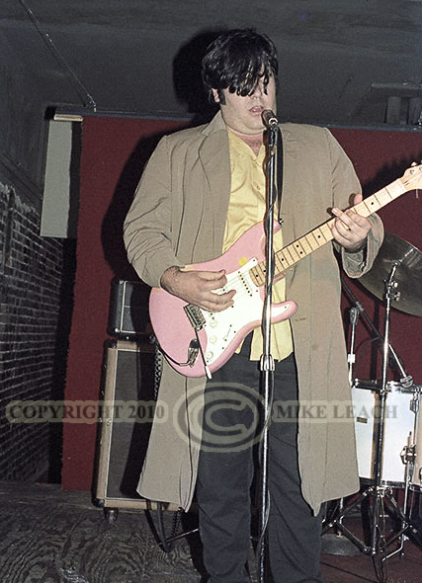
There are stories about Courtney Love and a trip Napalm Beach took to play at the University of Washington HUB in Seattle, October 1981. I don’t think any of those stories can be corroborated and they all conflict with stories she has told about herself. The one story I do believe about this trip is that Courtney left an oversized Columbo-style overcoat in the van which Chris later wore (seen here at the Wrex in Seattle, 1981 – the club that later became The Vogue).
Courtney Love was more than a girl who just happened to show up in Portland and find a place in the Napalm Beach band house. Her role was part of a bigger tapestry and it’s been difficult for me to figure out just what, and how much to say about that. There is a bigger background here that includes mass exploitation of children in various ways, including sexual exploitation of children – by our intelligence agencies, and supported by the Department of Justice. Chris’ encounter with Courtney fits into this background. She was just one of a series of honey traps set up for Chris by the FBI/CIA.
Throughout his book, Danielson states that Chris “participated” in the Satyricon “riot,” almost as if it were self-evident. This is not true, and in fact it is the first time I’ve heard such an assertion. I don’t even know if Chris was there. My sense is that he was there – but he was not involved in the fracas in any way. Napalm Beach did later play a “First Amendment” benefit show to “help keep Satyricon open.” I’m not sure to what extent Chris was paying attention to what seems to have become an ongoing conflict between Satyricon and Officer Balada. Balada had taken offense to a photo or artwork hanging inside the club, and was suing for damages. I do know that Chris viewed his civic rights and responsibilities the same way I do. He just didn’t ever really think he would find himself in a situation where his expectation of personal privacy or right to speak out would really be under threat.
The event that came to be called the Satyricon Riot should be looked at more deeply, not because Chris was involved, but because it seems to have been a significant event in the history of Portland music, shedding light on the club scene, and on police activities.
There are other things that could use further clarification, but these are the issues that so far have come to mind, that I really felt it was time to clarify.
Generally speaking, Chris was, from my perspective, over-concerned about what people would think about him, should he rock the boat in certain ways. He cared about people’s feelings and he tried to shoulder responsibility for his own actions, from my perspective, to a fault. Many who knew him, or who had been clued into this, and who had something to gain from keeping Chris in the dark, exploited this and other parts of his personality, using these characteristics to manipulate his behavior and to attempt to drive wedges between him and me. Out of respect for Chris, while he was here, I avoided weighing in on certain things. But I think that failure to correct false or misleading stories around Chris has led to damage, including undeserved damage to his reputation. I’m not claiming that he was perfect, nor am I claiming to be unbiased – I just think that the facts are important.
– Erika Meyer
Originally published September 2013 on collapseboard.com
I’ve tried to write this story, or something like it, a few times, but always got mired. Then, on July 11, something about the way two contrasting images cut across my brain – the 25-year-old daddy-band Mudhoney surfing across the blue skies of Seattle, while the 33-year-old granddaddy-band Napalm Beach says farewell from deep inside the Star Theatre – made me think it’s time to finish.
I used to tease Chris by calling him “the rock star only other rock stars know about”. His musical history spans nearly 50 years, spent almost entirely in the Pacific Northwest. His underground roots extend back to the 60s. He loved Hendrix and Iggy and the Dolls and [then went punk – as he understood and defined it – after seeing the Ramones play Portland in 1977.
Over the past four years I have learned that Chris’ memory is outstandingly reliable. This is crucial, because in the late 90s, he lost everything. When recalling events, Chris doesn’t exaggerate details to inflate his own importance. Fans and friends who uploaded photos and flyers to websites have also been helpful in piecing together his story. If there are factual mistakes, they are probably mine. But I’ve done my research, too. Though my bias is clear, I have tried to understand and present this as honestly as possible.
I understand the place in rock’n’roll for tall tales, legends, and myths. But this is about truth and authenticity.
If I meander, it’s because I only began to truly understand as I was writing. It is probably the most difficult thing I’ve ever written, at least emotionally. I am a songwriter, and a guitar player, and this is all meaningful to me. I grew up in rural northwest California, but I have roots in Seattle and other parts of Washington. I was born there, in Friday Harbor. I’ve lived in Portland for 13 years. I haven’t really been out of this region for over 20 years. This gives me a street-level point of view that is different from other writers. I hope this story will be interesting to Collapse Board readers, and I especially hope it will inspire some positive shifts in honesty and inclusiveness when it comes to the history of our music.
The embedded videos in this essay are mostly songs which serve as text, subtext, and context. This is about 8,000 words and about 1.5 hours of music. I felt it was important to be thorough. For those who want to return to the videos later, there are two YouTube playlists, one for the local news punk scene reports and one for the music.
Take your time. There is a lot of good stuff here.
On July 11, 2013 my partner in music and life turned 60 years old. To celebrate, and to shift everyone’s focus, he set up a show at Portland, Oregon’s Star Theater, an old burlesque house transformed into a rock club. A local weekly called it “an exorcism masked as a celebration”. With this show he meant to bring closure to his old music projects, in particular, to his band, Napalm Beach. To prepare, he worked with 13 different musicians comprising five different bands from the past 33 years. In all these bands, Chris was the ringleader, songwriter, composer, arranger, vocalist, and lead guitarist. That’s just how it’s always been (at least until our band, Boo Frog, when he moved over, a little, for me).
With about 200 people in attendance, the club was full, but not overflowing. Two drum kits and all the players’ amps were set up ahead of time to expedite transitions. For the final number, ‘Why Do Parties Have To End?’ all band members from over the years came up and played guitars, basses, drums, keys, tambourine, all at once.
Meanwhile, upstairs, Flying Heart Records discreetly and without permission, set up a massive merchandise table from which they sold all manner of Napalm Beach and Snow Bud and the Flower People CDs, LPs, 45s, comic books, and T-shirts. Someone asked me, “Who’s that guy selling all the stuff?” I looked, I saw, and I left it alone. Because I didn’t want to harsh the buzz. Because all this is almost over. At the end of the night Flying Heart Records pocketed all the merch money, and disappeared into the shadows. For 26 years it’s been this way. Flying Heart Records manufactures and releases materials without notification or permission. Snow Bud and Napalm Beach never see an accounting, and they never see a dime.
That same day, three hours drive north, Sub Pop Records kicked off their Silver Jubilee by having their flagship band, Mudhoney, perform atop the Seattle Space Needle 500 feet above a crowd of 40,000. The event was covered by PBS, NBC, Billboard, and Rolling Stone. A SUB POP flag flew from the top of the Space Needle. King 5 news noted that, “Sub Pop Records is credited with putting Seattle on the pop-music map with bands like Nirvana, Soundgarden, and Mudhoney. The record label continues to bring big money into Seattle to this day.”
Meet Napalm Beach, the most influential band you never heard of. Popular, prolific, and formed in 1980, they were based out of Portland, Oregon.
They taught Seattle how to rock.
That’s right. Someone had to throw down and show them how it is done. And now someone has to start shoveling the dirt off this band which has been buried too deep for too long.
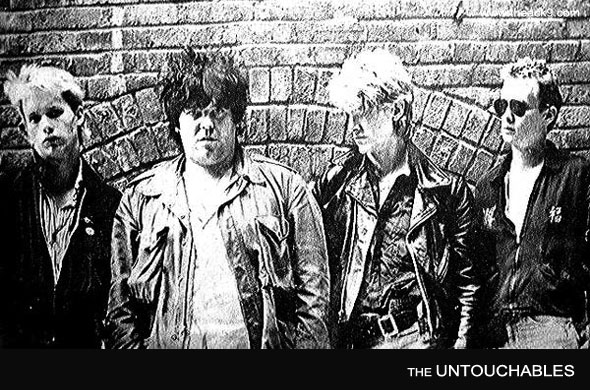
Why was Napalm Beach buried?
Let’s start with the obvious. They were underground. The music was rock, but beyond that, it was diverse, hard to pin down. They were mature (virtuoso) musicians in an amateur punk scene. They were raucous, headstrong, hard to reach. They didn’t think much about business. They just wanted to play live, record, and release albums. By the late 80s, they were all known drug addicts. That was the point that they became involved with Flying Heart, a tiny Portland “label” which did little but try to control them with favors, drugs, lies, and tiny bits of cash exchanged for recordings and publishing rights.
Also, except for a few well-received European tours, and a couple years in San Francisco, Napalm Beach never played a show outside the northwest. They spent their career (1980-1996) opening for touring bands, playing little gigs all around the northwest, and headlining at punk and rock clubs in Portland and Seattle, again and again and again.
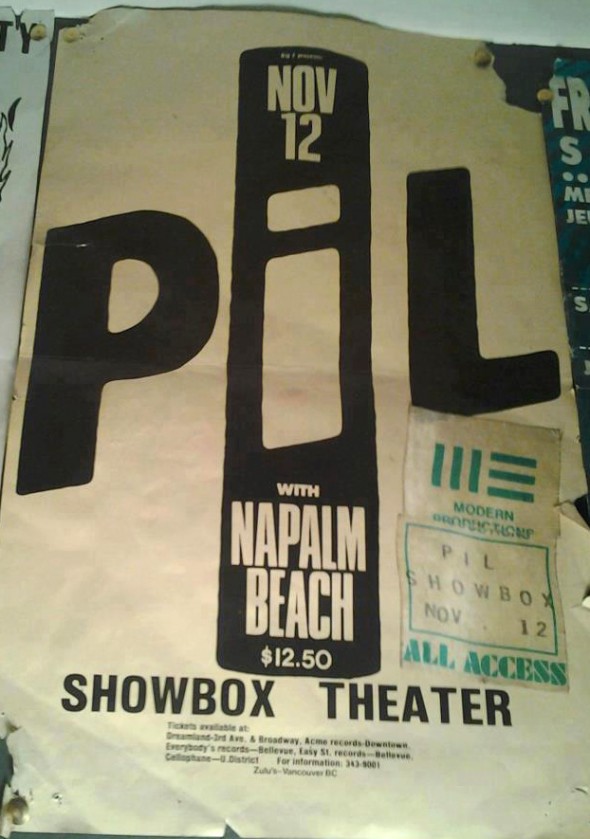
They were ahead of their time. They were dangerous. They were from Portland. They didn’t sign to Sub Pop. Their catalog was scattered, and by 1998 the bandleader was living on the streets in a cardboard box. These could all be factors.
Nonetheless, there is a reason why Zeno Records continued to quietly market their music into the 21st Century. And there is a reason why they were inducted into the Oregon Music Hall of Fame. And there is a reason why, when they broke up (after 15+ years and many albums), their fans demanded and attended reunion shows for almost two decades afterwards.
It wasn’t because they sucked.
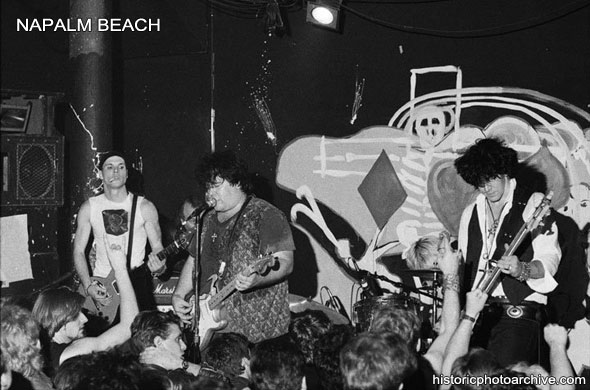
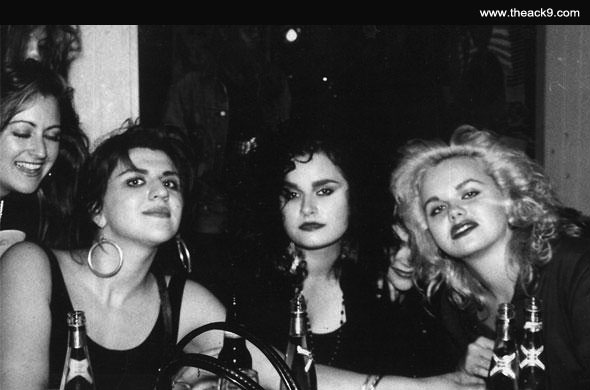
![]()
Like most American punk scenes, the Portland punk scene materialized in 1977 immediately after the Ramones blasted through town. The Portland punk attitude was (and is) about throwing out old rules and starting something new. That is why such diverse art sprang from it. Napalm Beach, in 1980, seemed to drop straight from the sky. They actually came from Longview, Washington. They arrived in Portland ready to rock and conquer. They connected quickly with the Wipers.
Like the Wipers, Napalm Beach was fronted by an older songwriter, Chris Newman, who, at 27, had been playing guitar since the 60s, and who was excited about the idea of creating a new type of music. Like the Wipers, Napalm Beach songs were influenced by psychedelic rock.
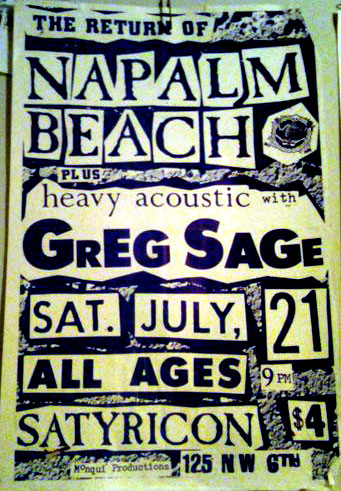
The Wipers’ Greg Sage was a creative and experienced recording engineer, and a respected figure in the Portland underground. He helped Chris record his first albums, asking for no money, and allowing Chris to keep all publishing on his music and art. When an album made money, Sage paid royalties.
In 1983 Napalm Beach opened the Wipers’ Over The Edge album release show. In 1986 Greg had Chris paint the album cover for his album, Land Of The Lost, which he would release on a new punk label, Restless Records. When the label didn’t think the image of cartoon dinosaurs roaming the ruined streets of Portland was “punk” enough, Greg suggested that Chris add a human skull in the middle. That is what made it punk enough for them.
Restless Records has since been consumed by Warner Brothers, and many of its titles are now out of print.
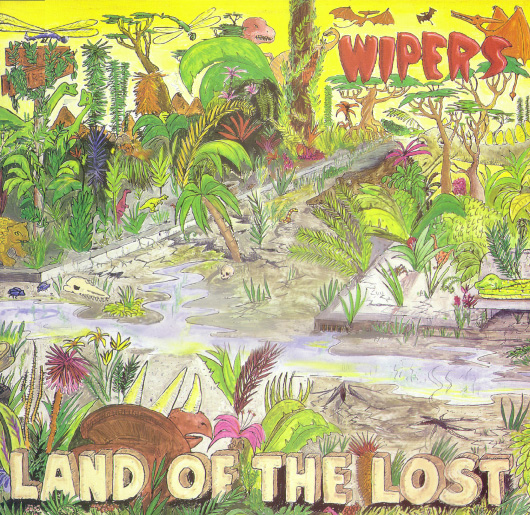
Napalm Beach lyrics and vibe were party-oriented at first, sometimes ridiculous (seriously. this is rock n’ roll). Later they grew darker, heavier, more autobiographical, and more confessional. Chris has never shied away from writing a quiet song, a love song, or playing an audacious Hendrix-tinged guitar solo. Sonically, Napalm Beach was intense, expressive drums (that’s Sam Henry – until October 1981 Untouchables/Napalm had Chon Carter who’s simpler new wave style and can be heard on Trap Sampler, where he played on both the Wipers and the Untouchables cuts ) fuzz, feedback, solid bass riffs, searing guitar (that’s Chris). They also wrote quiet melodic songs. They drew from many sources. The music never stayed still long.
They recorded many albums. At first they recorded with Sage, then they self-recorded on 4-track, and later in various low-budget studios in Oregon and Washington. They recorded two albums in Germany. To save costs, Chris learned early on how to record and mix a full-length studio album in 2-5 days. Napalm Beach made some great albums on an ultra-low budget, but they were an exceptional live act.
Through all of the 80s and into the mid 90s, Napalm Beach played original music in Portland, Seattle, and surrounding areas.
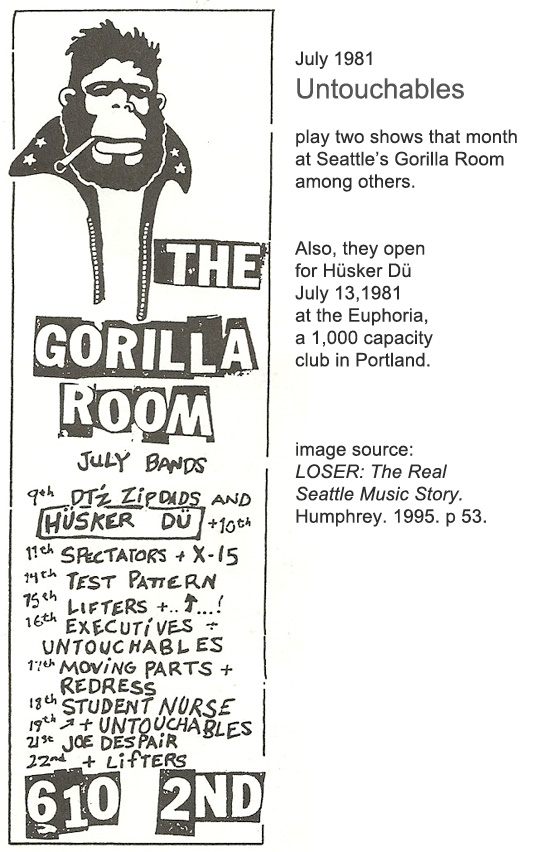
Once they began to tour Europe in 1989, they played fewer local shows. Once Nirvana broke through the stratosphere in 1991, nothing was quite the same.
Also, there was an early 80s lull. In Seattle, the Gorilla Room closed in September 1981, the Wrex February 1982, and the Showbox March 1983. Meanwhile, in Portland, The Met closed in January 1983.
The Gorilla Room had closed because of multiple liquor law violations. Underage patrons found onsite included Duff McKagan and Chuck Biscuits (Humphrey 68). Napalm Beach (who were still called the Untouchables) closed down the Gorilla Room. The place was packed and everything and everyone was sloshing under a layer of beer. They partied until they passed out onstage. That was the end of the Gorilla Room.
As for Portland, Napalm Beach had ruled The Met[1], a popular all-ages hangout, through 1982. Courtney Love was a regular there. It is where Chris met The Cramps, and saw them perform. Napalm Beach and everyone partied at The Met on New Years Eve 1982, not knowing that on January 1, 1983, the doors would close for good.
At that point the scene seemed to have dried up, at least as far as good places to play original music. This is when Napalm Beach decided to move to San Francisco (they ran into Courtney down there too). They did return to Portland and Seattle to play a couple out-of-the-way gigs, and to record Rock & Roll Hell with Greg Sage. 1983 is also when a punk club called Satyricon opened in Portland.
Satyricon’s philosophy was “a free stage for all”. Painters, poets, performance artists, film makers, street crazies, and musicians all gathered and collaborated there. When Napalm Beach came back for a visit in February 1984, they saw a revitalized underground scene. That is what inspired them to return to the northwest, which they did, summer 1985. They moved back to Portland and continued to travel to Seattle for gigs. They played Seattle’s Bumbershoot Festival in September and Johnathan Poneman’s KCMU benefit show (Live from the Rainbow) on October 18.
1985 is the year Jonathan Poneman moved to Seattle, Washington. In 1986 he joined forces with Bruce Pavitt who, in 1980, had started a zine Sub Pop. With help from friends in the Seattle scene, Poneman and Pavitt began to turn Sub Pop into a record label, and a brand.

One of the things that is sometimes exasperating is watching people try to figure out where, when, and how northwest punks began to incorporate elements of 60s and 70s psychedelic rock. Most writers credit Mudhoney (and their generation) for these innovations. That’s because Chris has been left out of the story.
If you look at west coast underground rock as a continuum, as I do, Jimi Hendrix had a tremendous impact. The power trio, the bass and drums holding down a solid groove while the guitar goes crazy with feedback and noise – Jimi was the innovator. Jimi’s main effects were fuzz and wah. However, fuzz tone had fallen out of fashion in rock music by the 70s. The Cramps, and Chris Newman, brought it back.
Here are some things I know about Chris as a musician. He has a sharp memory, an ear for melody, and a natural ability to arrange instruments. In addition, he has a driving need to express himself verbally, and through his guitar, and to embody all that is REAL, and all that is rock’n’roll. Simply put: it is his calling.
He grew up in a tight-knight evangelical Christian family. When he began to play, they told him he was playing the “devil’s music”. And he literally believed he could burn in hell for playing it. And he deliberately, consciously, decided that he loved rock’n’roll music so much that he was willing to burn in hell for it.
And then he did burn in hell for it. When he came out of hell, he was still playing, better than ever.
That’s how seriously he takes his music.
He is foremost a guitarist and songwriter, but he also plays bass, drums, keys, whatever. He got his first acoustic guitar at age 13 and his first electric at 14. He was also 14 when acquired his first effect pedal: a Fender Fuzz-Wah. Because, Jimi Hendrix.
At 17 Chris mowed lawns to save up money for an Electro-Harmonix LPB1 distortion pedal which he purchased from the classifieds in Rolling Stone (Issue #2). That was his introduction to Electro-Harmonix. In 1969, Electro-Harmonix developed the Big Muff π. Supposedly Jimi Hendrix was the first musician to buy a (work in progress) Big Muff – but Chris must not have been far behind, because ever since the early 70s, the Big Muff fuzz and Crybaby wah have been his main – and usually his only – effects.
In the 80s – especially the early 80s – Chris also used an Electro-Harmonix Small Clone chorus pedal. The chorus effect was invented in the late 70s. Chris bought a Small Clone in 1980 (likely about the time it first came out), incorporating it into his sound immediately. (You can hear it, for example, on these albums: Trap Sampler, Rock & Roll Hell, and Pugsley.)
Years later, these combinations of effects would become associated with Mudhoney (fuzz/wah) and Nirvana (distortion/chorus).[2]
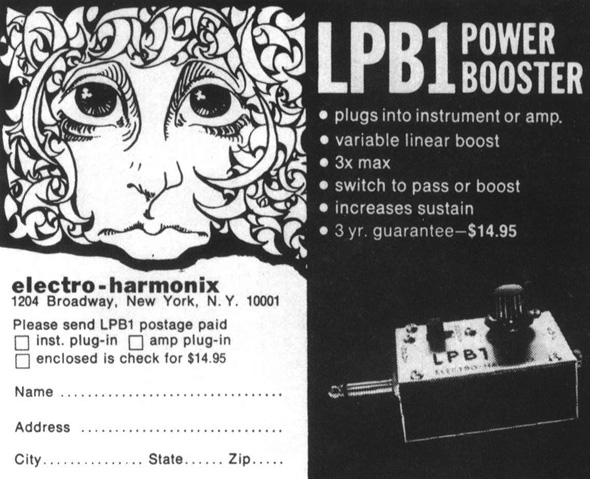
As for guitar and amp, in Napalm Beach, Chris started out playing his pink fender Strat (that matched his pink converse high-tops) through a Marshall stack. Later, and for many years, his main ax was an old Gibson Flying-V bought from Fred and Toody’s Tombstone Music store.
After seeing the Cramps in 1982, and their original two guitar, Fender Twin reverb-and-fuzz attack, Chris added a Twin Reverb amplifier to his setup. He refashioned a headlight dimmer switch to an amp switcher. For his Napalm Beach shows he could now use the switch to select either the Marshall, or the Twin, or both amps together.
For Snow Bud and the Flower People, the pothead joke band developed in winter 1985, Chris drew on the Cramps’ influence, stripping down to Twin Reverb, Big Muff, wah, and solid, primitive drums. Snow Bud’s first show was in Portland at Satyricon, January 28, 1986 (the Space Shuttle Challenger had blown up that morning). Unlike the Cramps (more like Hendrix), early Snow Bud songs featured heavy hooky bass riffs. For early live shows, Chris put Sam Henry on bass and (future) Dead Moon drummer Andrew Loomis on drums. Later Snow Bud became its own band, with Nathan Jorg on bass and Lance Paden on drums, a lineup which lasted from 1993 to 2013.
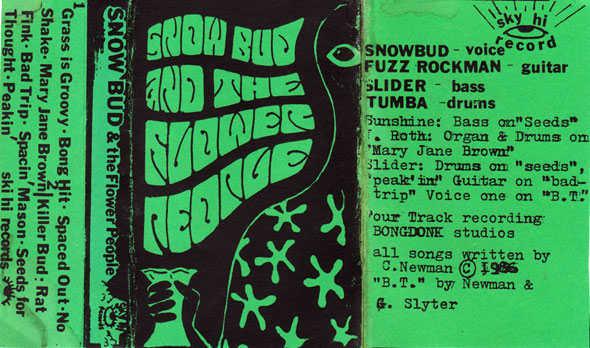
Snow Bud’s first two cassettes, a bunch of songs that were written title-first in a single night (Killer Bud, Bong Hit, No Shake, etc) were popular with the underground kids. Chris sold a couple dozen at each of his first two Seattle shows (early ’86), and they were sold in independent record stores around Seattle, Portland, and eventually, San Francisco.
At one of those first Seattle Vogue shows, Green River frontman and KCMU DJ Mark Arm arrived as Chris was setting up his gear. Mark carefully examined all of Chris’ gear – the Fender Twin Reverb, Big Muff and wah that he used to get his signature Snow Bud (now – sans wah – Boo Frog) tone.
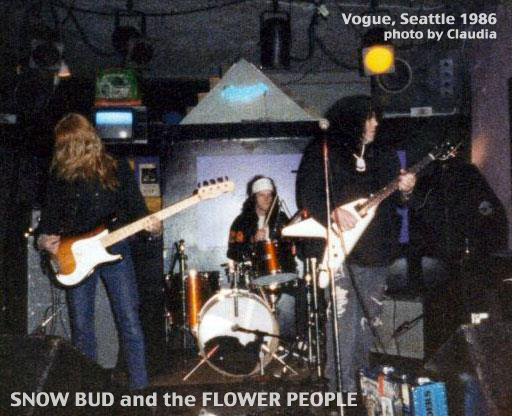
After the show, Bruce Pavitt found Chris backstage. Pavitt introduced himself and said he had a new label, Sub Pop, and that he was interested in Snow Bud. Chris said, “Sounds great”, and put the Sub Pop business card in his pocket. He didn’t have a manager at the time, or a phone, and he never called Sub Pop.
Sub Pop’s first records were Sub Pop 100 comp (1986), and Green River Dry As A Bone (1987). Meanwhile, Mudhoney had acquired and was using the Fender Twin/Big Muff combo by 1988. It is an integral part of their tone to this day.
(Gift, of course, is German for “poison”)
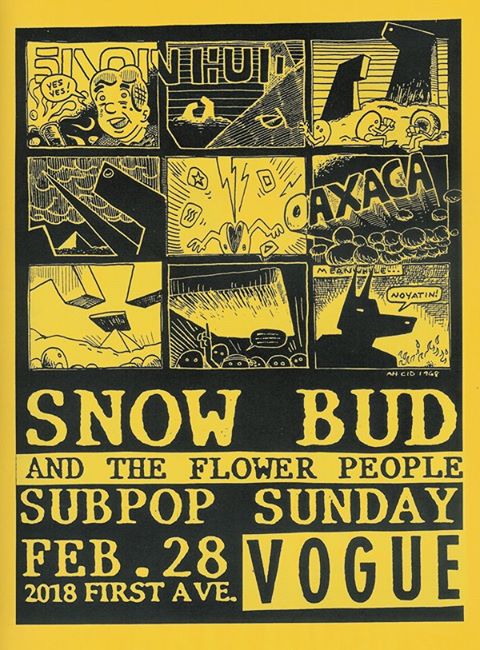
Was it unfortunate for Chris that he never signed with Sub Pop? Probably not.
I know that for most of his career, Chris didn’t think about his music in a strategic, businesslike way. He understood early on that he wouldn’t get rich or famous playing punk rock in the northwest, so he stayed busy playing to enthusiastic crowds in alternative clubs and all-ages venues. He lived gig to gig and record to record. He moved around a lot, didn’t have a phone, and relied on others (not all of whom were trustworthy) to relay messages to him.
Not to mention, Snow Bud was a joke band (that somehow lasted 27 years). It was supposed to be a side project, not an identity. And in the late 80s, I don’t think that either Sam or Chris would have handled fame or money well. So there should be no regrets about any of that.
My only issue, as far as Seattle is concerned, is that Chris, Snow Bud, and Napalm Beach have all been deleted from the narrative of 80s northwest underground music, especially when it comes to Seattle. That’s not accurate, and it’s not right.
Sometimes I wonder if it’s an old rivalry that keeps everyone amnesiac.
In the early 80s, Napalm Beach opened for national touring acts in Seattle such as Johnny Thunders And The Heartbreakers and X in 1981, and PiL in 1982. Some Seattle punks were angry about that. Seattle bands at that time didn’t have the chops or songwriting skills that Napalm Beach had. Seattle punks gobbed Napalm at PiL[4] and threatened to riot at Johnny Thunders[5].
Napalm Beach might have made some enemies.
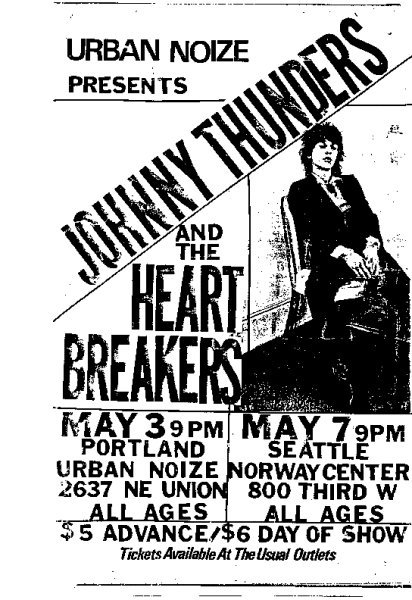
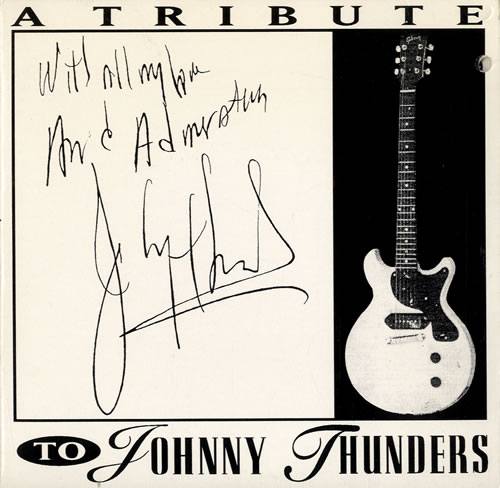
Bodhi (from the verbal root budh – to become aware, notice, know or understand) is the understanding possessed by a Buddha regarding the nature of things. It is traditionally translated into English with the word enlightenment and literally means awakened. (from Wikipedia: Bodhi)
In 1966, as soon as Chris got his first guitar, he was writing songs. He wrote the main riff to the song ‘Why Do Parties Have To End?’ when he was 13. At 14 he brought his guitar and fuzzbox to Christian boarding school. It was 1967 and he wanted to be a hippie. Underground. A head.
Chris grew up in Seattle, New Orleans/Mississippi, San Jose, and Longview (town of his birth). In 1972, at the age of 19, he joined a Longview hippie band called Bodhi. He was their youngest member as well as their lead vocalist and lead guitarist. Bodhi was intent on working the northwest club circuit, which meant a strict limit on originals. (The fact that they played any original music at all made them stand out.) Chris and bandmate Spyder wrote the originals, but mostly Bodhi covered psychedelic underground hits – music by acts like Deep Purple, Black Sabbath, Spirit, Hendrix. Bodhi lived in a house together, ate hippie food, smoked homegrown weed, had plenty of gigs.
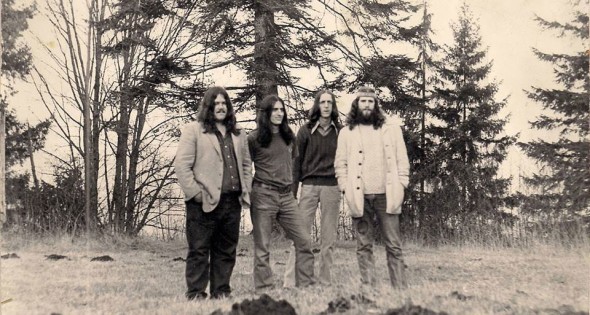
A year and a half later, Chris had fallen hard for the New York Dolls and glitter rock. So he left Bodhi to form his own glitter rock band. This new band would play nothing but originals. The cover-band club gigs fell away. They went to Santa Monica for a few months to try and “make it”. They lived on the beach in Malibu, did acid, jammed, starved, partied, were thrown out, and finally returned to Washington to start again.
Chris began to date a woman who worked in a record store. One day she brought home Iggy’s Metallic K.O.
He became enamored with, and began to study, Iggy, and the Stooges. Soon there was a buzz in the air about the “new wave”. When the Ramones played the Portland Paramount in 1977, Greg Sage, Chris Newman, and everyone else bought a $1 ticket.
The Ramones’ set was blistering.[6] They got horrible reviews. Chris thought “I’m going to start a punk rock band”. By this point he was an accomplished musician with 10 years of experience on guitar. But he loved the primitive abandon of punk, and the idea of throwing out the rules. When he started his punk rock band, he didn’t think about anything but playing what he wanted, the way he wanted to play it. He incorporated pop, glitter rock, garage rock, psychedelic, and new wave. This was 1979, and that band, first called the Goners, then the Untouchables, would eventually move to Portland, pick up the Wipers’ original drummer, Sam Henry, and become Napalm Beach.
1979
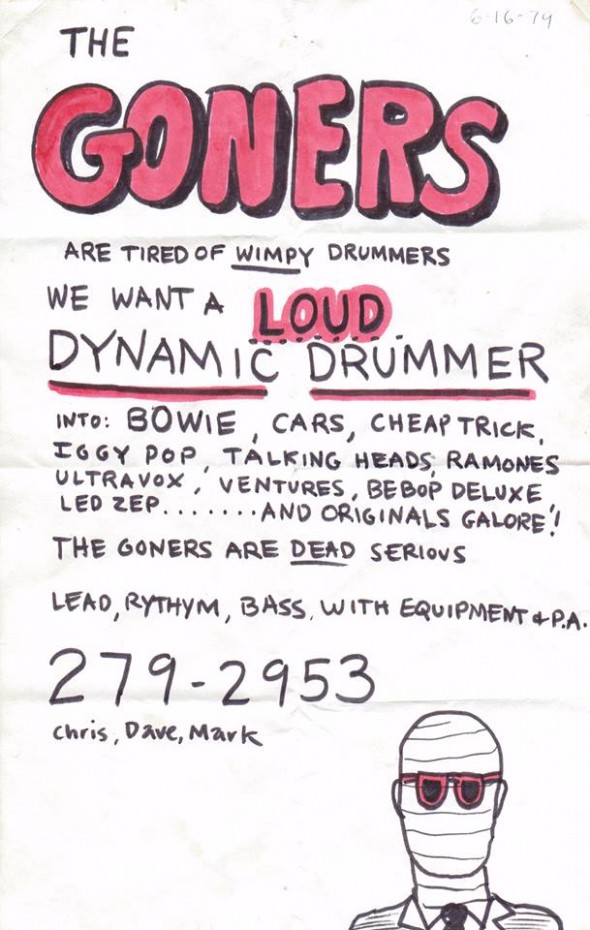
There were groups like the Blackouts from Seattle who were being completely ignored, and then from Portland you had Wipers, who to this day I think are one of the greatest rock bands in the history of American music, who were putting out their own records and being completely ignored because they were from Portland. They did not have access to media. – Bruce Pavitt, to Pitchfork. July 7, 2008.
In 1980 the Untouchables moved from Longview to Portland and got straight into the punk scene. It was a scene that included bands like Pell Mell, Styphnoids, Smegma, Sado Nation, Wipers, and Neo Boys[7].
The Untouchables immediately caught the attention of local ‘music biz’ types who were scouting the underground for potential radio-friendly acts (“They wanted me to be the next Quarterflash.”) Chris did not like these smarmy types. He wanted success, but under the circumstances, he didn’t expect it. He wanted to make music with no rules. He didn’t want to give up his individuality. To ‘make it’, they would have moved him to New York or Los Angeles (because that is how it was done), and they would try to make him get skinny (impossible), change his image, change his music. He didn’t want to do it. At the same time, Chris is an artist, and he wanted to record, and to be heard. So Greg Sage offered to record and release the Untouchables, helping them bypass the commercial system. Then, when a copyright dispute came up over the “Untouchables” band name, Chris renamed the band “Napalm Beach” to make it sound more underground and less commercial.[8]
In October 1981, after Napalm Beach had recorded the songs for Trap Sampler, Sam Henry left The Rats[9] to join Napalm Beach. Sam is partly blind, holds his drumsticks like a jazz player, loves Buddy Rich, and like Chris, is a lifelong musician. Before The Rats, Sam had been in the Wipers. It is Sam’s drumming you hear on the Wipers’ first LP Is This Real (1979) and on the Alien Boy EP (1980).
As far as Napalm Beach bassists, they came and went every few months, at least before 1989 when Dave Dillinger joined and stuck around. Chris writes (in varying levels of detail) all instrument parts to his own songs.
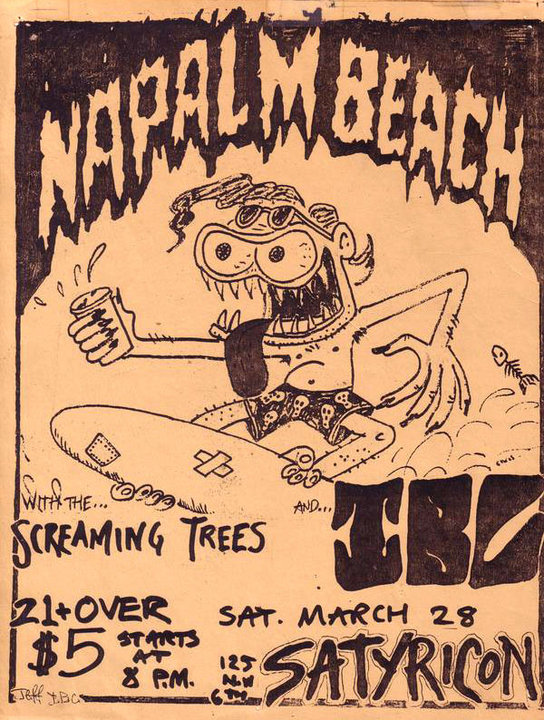
Here is how someone remembers Napalm Beach in the mid 80s:
From the standpoint of a local fan, the Teen Dream period from 1985 to 1986 marked the peak of Napalm’s success. They played the summer Bumbershoot Festival at the Seattle Center two years in a row, the first year on the large outdoor mural amphitheater stage, and the second year on a large indoor stage…
The highlight of a Napalm show at the Central in these days was always when they played “Road to Recovery,” usually in about the middle of their set… the audience would wait in nervous anticipation for the climax of the night.
…“Road to Recovery” was a roller coaster ride of alternating slow and fast, mellow and heavy. Climbing gradually up to the summit, with Chris quietly mumbling lyrics over a deceptively repetitive, hypnotic guitar riff, an intensely wild Sam Henry drum solo suddenly breaks out from nowhere raising Keith Moon’s ghost from the dead, the guitars hit a perfectly synchronized power chord, Chris belts out the lyrics’ chorus like an opera singer shouting, “I’ve got to stay alive, for the sake of rock and roll!”
— Eric N. Danielson, “On The Road to Recovery”[10]
“It’s got death in it. For someone like you, it probably appears to be a nice town. Like it’s all holistic and trees and arboretums. Bullshit!” – Courtney Love (Yarm p 216)

Seattle is not a cultural emerald surrounded by vast oceans of nothing. A more accurate analogy would be to see the Pacific northwest as a cultural watershed, with Seattle as a river’s mouth. The water doesn’t originate there, it flows in from other places and mixes there. There is and has always been plenty of cultural connection between Vancouver, Seattle, Olympia, Portland, and the smaller towns that feed in. Nonetheless, the mythology developed by Sub Pop in the late 80s and carried forth by the rest of the world to this day doesn’t recognize this.
Grunge mythology rarely recognizes a single pioneering act from Portland outside of the Wipers (for their influence on Kurt Cobain) and Courtney (for her influence on Kurt Cobain). Not surprisingly, Sub Pop only recognizes artists in which it is invested.
Considering that Portland’s punk/music/art scene blossomed before Seattle’s, and considering that you can easily drive from Seattle to Portland and back in a day, it seems strange to me that no one has looked deeper.
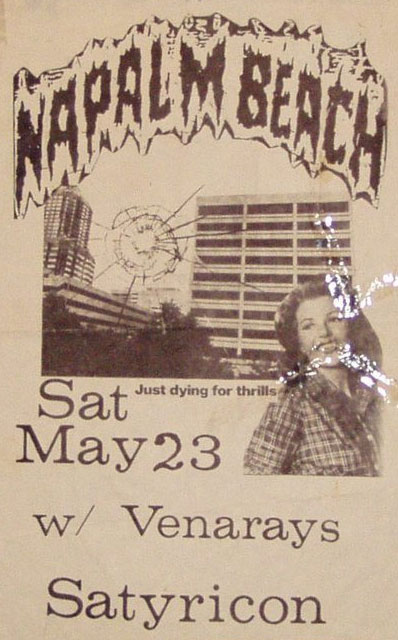
GRUNGE is a brand. It was created by Sub Pop (including members of Green River). If Napalm Beach or Snow Bud had recorded with Jack Endino – as they should have, because unlike most 80s producers, Endino understands their roots music, the 60s heavy underground – and put the album out on Sub Pop, they would have been a grunge band. But they didn’t, so they aren’t. Even though it can be argued (as I am doing) that Napalm Beach, as much as anyone, started the whole thing, they have never been included in the narrative. Mudhoney started grunge. Why? Because they were the first grunge band. The logic is flawlessly circular.
Grunge is problematic not only because it is proprietary, but also because it breaks down quickly. It’s undefinable. It’s not really a style, it’s not really an attitude, and it’s not really a genre. It’s not really anything. So why do we keep talking about it like it’s something?
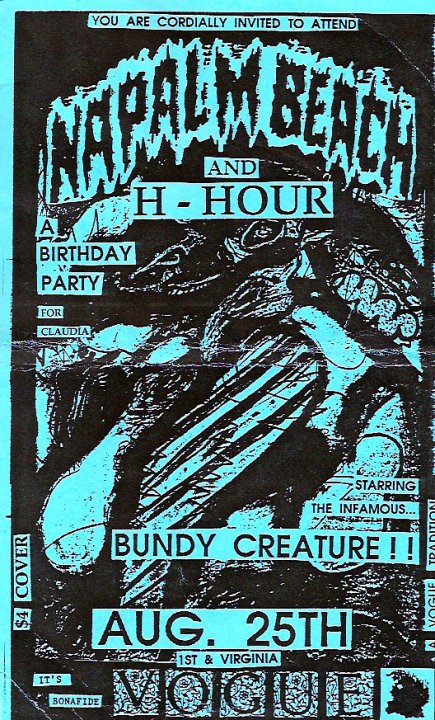
And who is really from Seattle? Although Sub Pop is a Seattle-based label, none of the Sub Pop executives associated with the origins of the label (Pavitt, Poneman, Jasper) are from Seattle, or even from the west coast. Bruce Pavitt was born in Chicago, Illinois. Pavitt moved to Olympia for college around 1979, and then he moved to Seattle in 1983. Jonathan Poneman was born in Toledo, Ohio (near Detroit) and moved to Seattle in 1985. Current Vice President Megan Jasper is from Amherst, Massachusetts, a college town on the east coast about 5,000 km from Seattle. (Where Dinosaur Jr. comes from.) She moved to Seattle in 1989.
It is not unusual for new-in-towners to see and appreciate (or laugh at) things that locals miss. That said, it is really hard for me to understand why writers and journalists accepted, and continue to accept, the original Sub Pop executives, and their closest friends, as the go-to experts on nearly everything northwest. By now Sub Pop’s original grunge mythology is so entrenched that latter-day attempts to add broader view are consistently brushed off as unimportant.
The more powerful write the less powerful out of history. I get it. I just don’t accept it.
Underneath grunge, and everything around it, there truly is something beautiful and real. The silliness and seriousness and vitality in our punk/underground. Seattle, Olympia, and Portland are very different towns, but geographically close and deeply connected.
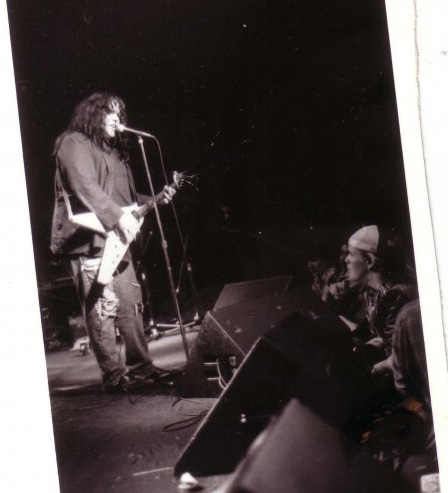
The punk rock aesthetic was interpreted by different people from different parts of the northwest, all of whom partied together, dated each other, dated each other’s ex’s, traded cassettes with each other, wrote each other letters, read each other’s zines and journals and graffiti, played music together, hated each other, liked each other, went to the same shows.
Through their constant live performances and numerous underground cassette releases, Napalm Beach won many northwestern teens to their cause of ROCK N ROLL! In Seattle, they came on like gangbusters. They had no real competition at first. They played The Wrex (which became The Vogue), The Gorilla Room, Astor Park, Off Ramp, Golden Crown, Baby-O’s, Ditto’s, Central, Graven Image, and many of those big old rented halls and granges used for all ages punk shows. They played week after week, month after month, year after year. Trips to Seattle could last two weeks, with the band playing 6-10 shows in that time span, all around the Seattle area. They might play a club gig, then an after-hours gig later the same night. They were original, on fire, relentless.
In addition to playing all these shows, Napalm Beach took every possible opportunity to record. When they released an album on cassette, they sold it at their shows and independent record stores all around Portland and Seattle (and to a lesser extent, San Francisco). They were featured first on Greg Sage’s Trap Sampler LP (1981). Then Trap released Live At The Met (1983) and Napalm Beach’s first full-length album, Rock & Roll Hell (1983), on cassette. Chris recorded, mixed, and released their third album, Pugsley (1984) himself. Teen Dream was funded by then-manager Doug Reed and recorded with Bill Stuber in Seattle at Triangle Studios on 24 track. Teen Dream was released on cassette in 1985, and on vinyl (as a self-titled album) in 1986. Napalm Beach now had a vinyl LP. That meant something. And they continued to play show after show and release album after album into the northwest punk and underground rock scene up through 1996. Beginning in 1986 Chris was also performing and releasing albums with Snow Bud and the Flower People.
A quick perusal of Wikipedia tells me that Mark Arm and Gary Lee Conner turned 21 in 1983, Kat Bjelland turned 21 in 1984, Mark Lanegan, Courtney Love, and Jack Endino in 1985, Krist Novoselic and Steve Turner in 1986, Stone Gossard and Andrew Wood in 1987, Van Conner and Kurt Cobain in 1988.
It’s a fact: Sub Pop’s late 80s Seattle-based artists grew up on Napalm Beach.
Ugly people weren’t allowed to rock before us. – Mark Arm, as quoted in Rolling Stone Sept 2011.
Part of Sub Pop’s grunge myth is the image of an underground rocker who doesn’t care about being commercial. The greasy haired “loser” sleeping on floors, the big lumberjack playing heavy riffs, the small town rambunctious kids who just don’t give a shit. They just want to rock! Napalm Beach look like the prototype for this image, for both musicans and marketers.
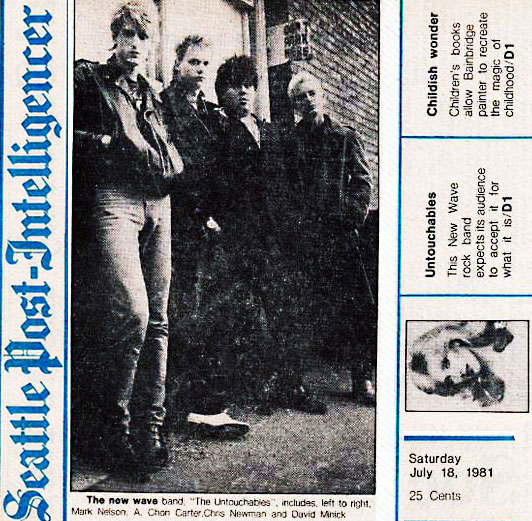
Here’s Charles Cross writing for the Post Intelligencer, Seattle’s main daily (morning) newspaper, 1981:
…Chris Newman looks anything but the typical pretty boy rock star… Newman sports a girth that makes managers of all-you-can-eat restaurants turn over the closed sign when they see him walk down the street. He has a wild unkempt mop of hair, a 10 o’clock shadow and on stage tonight he’s wearing a greasy black wino’s raincoat.
Newman spends so much of his time sleeping in cars and on the floors of the bars the band plays in, that his personal hygiene habits leave something to be desired. In short, he’s the type of guy that if you saw him walking down an alley, you’d high tail it in the other direction.
But tonight on stage Newman uses his gruesome body to create some of the great gruesome driving rock n’ roll. Backed by the three other young bad-boy types that make up the Untouchables, Newman breaks into the band’s signature tune “Rock & Roll Hell” and all hell breaks loose in Astor Park as the dance floor fills up and the place becomes so hot you could cook hot dogs on the roof. The Untouchables have just begun their set and from the opening riffs of their first song they have the audience riveted to the wall with their driving, highly original new wave rock…
After their set, and the two encore tunes, a magic seems broken in the hall, as if some great sword had been pulled from the stone for a few short minutes and has now been replaced… One of Seattle’s most successful established bands has just been upstaged by some of the poorest, ugliest, and most talented rock n’ rollers in town.
Charles R. Cross “Band drives stake through heart” Seattle Post-Intelligencer July 18, 1981
Ok, you’ve come this far. Let’s talk about Courtney Love.
Here is Napalm Beach playing a version of ‘Rock & Roll Hell’ in Seattle around 1981/82 – in the video/slideshow, Chris wearing a beige over-sized coat that belonged to Courtney Menely who would later be Courtney Love. She wasn’t a musician yet, but she had been living in the Napalm Beach band house and she was paying attention. She travelled to Seattle at least once with the band, and by the time of Mike Leach took these photos of Napalm Beach, Courtney was probably living in the U.K., writing Chris letters about hanging out with The Teardrop Explodes and encouraging him to come over there too.
Unlike most Portland musicians, Courtney could find money for traveling and so forth. Courtney Love and Kat Bjelland were both part of the Portland punk scene, a scene that was strongly linked to underground scenes in both San Francisco and Seattle.
Between 1986 and 1992 my friend David Ackerman spent a lot of time taking photos of bands, especially at Satyricon. In recent years, I’ve helped him license photos of your favorite Seattle bands for books and T.V. David usually photographed the stage, but sometimes he photographed people in the club (usually girls). Courtney Love was in and out of Portland in the 80s. In all his many hundreds of photos, David has exactly two photos of Courtney, both at Satyricon. According to David, the photo at the beginning of this article was taken at a Napalm Beach show in 1986 (The Obituaries opened). The other photo was taken at a Mudhoney show in January 1989 (Nirvana opened).
Courtney only lived in the band house for part of 1981, but Chris ran into her on and off at rock shows through the 80s and into the early 90s. The last time he saw her was at La Luna on her Live Through This tour. She greeted him through the mic.
Chris respects her and her work.
If you overlay the career path of Nirvana as a trajectory up, with the career path of Napalm Beach as a trajectory down, the center of the X would occur in 1991.
In 1988 a German-born couple associated with the Satyricon club formed Satyricon Records solely for the purpose of getting Napalm Beach to tour and release records in Europe. Despite being completely new to the business, Henk and Heike were professional, well-organized, and helped open up some great opportunities in Europe. German music magazine Spex named Moving To And Fro as one of the best albums of 1988, paving the way for tours.
With Satyricon Records’ help, Napalm Beach toured the European club circuit beginning in 1989. Their first tour traveled about two weeks ahead of Tad and Nirvana’s first tour, playing all the same clubs. “We saw graffiti and other signs of Napalm Beach,” Tad bassist Kurt Danielson told me once.
Napalm’s first German performance was notorious. They had never before experienced the kind of rock star treatment they received upon arriving in Europe. The Germans handed Chris shot after shot of Jack Daniels, “American whiskey for you!” He got drunk and destructive. The next day the Nürnburg club called the Hamburg club and warned them that Chris had trashed the entire backstage area (true), and raped a woman (not true).
Hamburg said “Send them anyway!” Chris reconsidered his approach, and the rest of the tour was spectacular.
At this time, Kurt Cobain would have been 22 years old and Nirvana almost three years old. Chris Newman would have been a boyish 36 years old and Napalm Beach almost 10 years old. In 1989, Chris had been playing guitar longer than Kurt Cobain had been alive.
Napalm Beach toured Europe again in 1990. Napalm Beach were in Europe on New Years Eve 1990/91, which meant that back home, Nirvana played Napalm’s usual New Years slot at Satyricon.
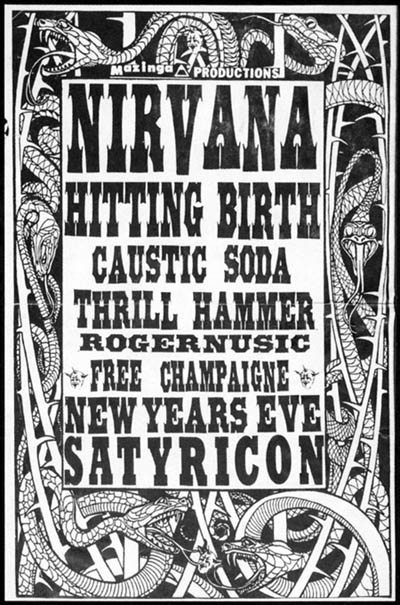
Then Napalm toured again in 1991, this time just tailing Nirvana. Nevermind began to rocket up the charts. Napalm played a beautiful club in Vienna and the owner told them how two weeks earlier, Tad/Nirvana had come through and they had to turn away 2,000 people at the door.
That is how fast everything changed.
December 1991
About 10 years ago Greg Sage revealed that Kurt Cobain took his life two weeks before his first scheduled recording session with Sage at Zeno. He said the sessions had been kept secret, something to do with Cobain’s label, and issues of control.
The story didn’t end there for Napalm Beach. They toured a bit more, they released some more albums, they made a few more mistakes.
Meanwhile, thanks to the efforts of Sub Pop, many of the kids who had grown up listening to northwest underground bands like Napalm Beach had become instant rock stars. In the process, some of Chris’ innovations in sound, stagecraft, and songwriting were attributed to younger, more famous artists. That’s OK. I think that Chris is more than proud to have been an inspiration for so many.
The problem is not the inspiration, but the omissions.
…really open and weird… weird louder, arty bands, as opposed to the quiet, sweet Olympia sound. – Gilly Ann Hanner of Calamity Jane, on observing the late 80s Portland music scene after living in Olympia
Because writers and researchers have continually failed to understand the dynamics of influence and competition between Seattle and neighboring towns, images of late 20th Century northwest rock music are consistently filtered through a Seattle/Olympia-slanted lens. 80s Portland punk/indie/alternative bands were almost all D.I.Y., and all buried under the great myth of grunge. Pioneering rock bands like the Obituaries and Calamity Jane became little more than a footnote in the Nirvana story. And a band like Napalm Beach just disappears completely.
Some seem to think all the invisibility kept Portland “pure” – but what musician wants to be invisible? or pure? or unheard?
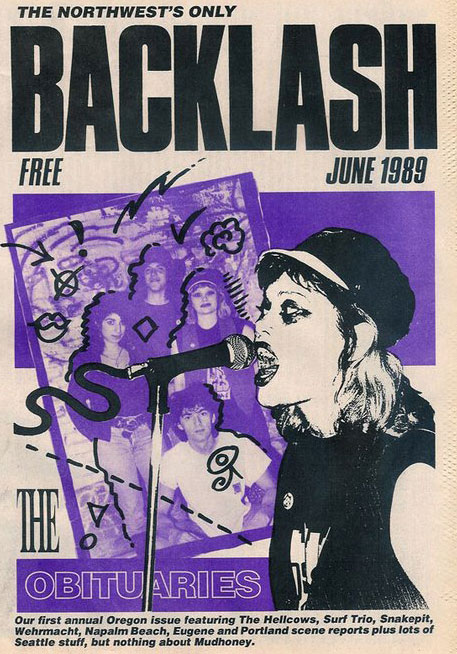
In 1996 Chris arranged and performed a tribute show in honor of Jeffrey Lee Pierce, who had recently passed away. He performed the entire Fire Of Love album. The following day, Chris was arrested for heroin possession, creating a cascade of events that ultimately led him to become homeless, losing everything – letters, records, original artwork, and years of journals detailing band experiences. At this point, he had effectively given up and resigned him self to the life, and death, of a street addict. He and his wife Valarie lived on the streets, mostly in San Francisco, for six years. He wrote and recorded two albums while homeless.
Ultimately, Chris and Valarie, both addicts, had to divorce in order to survive.
Chris spent about 25 years of his life struggling with heroin. He eventually served his time in jail and has been back in Portland actively working on his recovery for over a decade. He has been clean of heroin for over three years now. As long as he has love and stability, he won’t go back. Sam has been off heroin for 10 years, and will soon tour Europe for the first time since the 90s, with his band, Don’t. Bassist Dave Dillinger is also clean and well and has recently married. Chris’ ex-wife, Valarie, a writer, and prostitution recovery advocate, is clean and sober and studying English at a beautiful liberal arts college.
Chris and Valarie are still friends, and I think she’s cool too.
In 2009, Chris arranged a Cramps tribute show in honor of Lux Interior, who had recently passed away. I asked to play guitar for the tribute, and that is how we got together. When the tribute show was over, we were left with Boo Frog.
2012
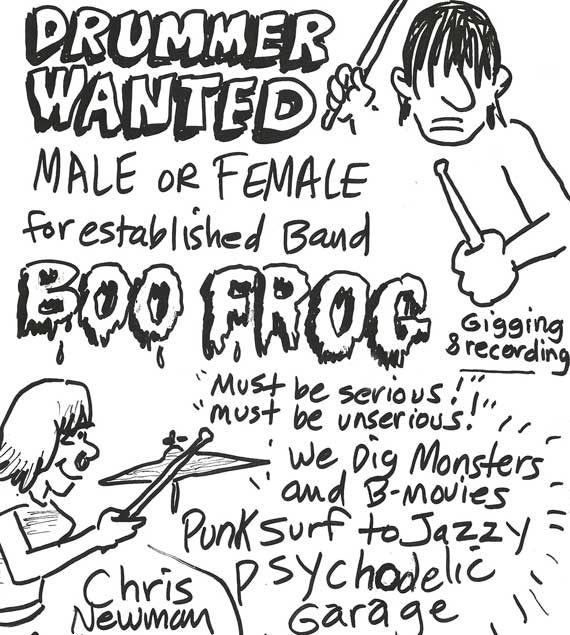
There are a lot of interweaving themes in this story, many conflicting agendas in music and society. To me, a musician, the overriding theme is the tension between commercial and independent music. I find myself ever-more respectful of what artists like Greg Sage struggled to achieve, and of the difficulties they have experienced trying to find the balance between getting one’s music heard, and losing control of it (and any income it may generate). I am also very grateful to him and to so many others who have gone out of their way to help Chris and other unusual or misunderstood artists.
Now with Boo Frog, Chris continues to write, play, and perform, and he will do so for as long as he is able. We will do a kickstarter to release Boo Frog’s third album. We are writing our fourth album. We also hope to raise funds to remix and rerelease Teen Dream, out of print since 1986. We will do as much as we can.
Chris’ songwriting continues to be prolific. He’s always weaving in new ideas. He still plays guitar every day. He has not toured since 1992 and very much wants to tour again before his health fails. He is still a top-notch performer, still gives EVERYTHING each time he gets on stage. He still approaches music and life with the openness and passion of a child who has lived long enough to know that where the old path ends, a new one begins.
[1] Portland and Seattle have had some similarly-named locations and venues. There was a Portland Metropolis (called “The Met”) and there was a Seattle Metropolis. Both were all-ages alternative clubs in the early 1980s. The Met (Portland) was a gay dance club that started having live music in 1981, got overrun by new wave kids, and closed January 1, 1983. It was downtown where Dante’s is today. The Metropolis in Seattle opened in 1983, was cooperatively run, and lasted nine months (Humphrey, 87).
[2] Kurt Cobain’s signature effects were a Small Clone chorus and a Boss distortion pedal (DS-1) that sounds a lot like the MXR distortion pedal which was an early Wipers sound.
[4] It appears that both Steve Turner and Mark Arm were both at the 1982 PiL/Napalm show. “I met Mark in October of ’82, right when my senior year started… we could never really decide if it was the Public Image Ltd show or the TSOL show where I met him in line.” Steve Turner, as quoted in Everybody Loves Our Town (Yarm, p 45.) Green River got their chance to open for PiL in 1986. This show went down in history for the “welcome” shown to PiL by Green River and co, and many people believe it inspired Lydon’s 1987 song, ‘Seattle’.
Mark: Yeah, it was pretty out of hand, but it was a reaction to seeing someone that you respected at one point turning into something that you imagine that at one point he hated.
Steve: I never respected him at any point, really.
Mark: The first three records are great. I saw them a long time ago and it was an amazing show.
[5] Untouchables opened for Johnny Thunders in Portland and Seattle Spring of 1981. At the Portland show, future Napalm Beach bassist Otis P. Otis (also mentioned in footnote #7) traded his Gibson Les Paul Jr. for Thunders’ duct-taped together (but autographed) L6 guitar.
According to Grunge Is Dead, the U-Men picked up their singer, John Bigly, at the Seattle Johnny Thunders show (Prato 54). It was an all ages show in a rented hall. The Untouchables let the Heartbreakers use their backline. Untouchables played a great set, but Johnny Thunders spent most of his set backstage doing drugs. Finally the Seattle punks lost patience and rushed the stage, shouting “Johnny Thunders sucks!!! Untouchables suck!!! Fuck you!!!” and looking like they were going to rip the stage apart. Johnny Thunders’ two travelling thugs then beat the crowd back from the stage with microphone stands and so forth, until the show was shut down.
Chris met Thunders one more time after that, on tour, in April 1991, while playing Xtasy Club in Berlin. Chris and Sam spotted Johnny in their hotel and invited him to breakfast. At this point, Thunders was touring with a sax player, playing to tiny crowds. He was alone and seemed down but cheered up as they talked, especially when Chris told him how much his music had meant to him. He told Chris and Sam that he was on his way to Hamburg where he would record with the Toten Hosen, and then use the money from the session to buy a ticket to New Orleans where he hoped to start a band with “a horn section and black chick backup singers” (Johnny’s words). He signed a blank page in Chris’ passport “with all my love and admiration”, before they parted ways.
Thunders died in New Orleans three day later.
Unlike what Wikipedia (currently) says, it appeared to Chris that, in Berlin, Thunders had been using heroin, and plenty of it. (No one knew he had been suffering from leukemia.) This does NOT make his death any less tragic or or the circumstances around it any less criminal.
[6] Here is an essay about that Ramones show featuring Otis P. Otis who came from Seattle to play guitar on the final ‘Why Do Parties Have To End?’ and who still looks spectacular. Writer Marc Covert also conducted this Greg Sage interview.
[7] Neo Boys were a fierce all-female Portland punk band. I do not think they ever toured. Neo Boys drummer Pat Baum is also a filmmaker (now a marine ecologist) who worked with both Greg Sage and Gus Van Sant. She helped Chris with a lot of cassette duplication over the years, and she documented Napalm Beach on film. She is the reason why we have beautiful live footage of Napalm Beach in 80s Portland. THANK YOU, Pat Baum.
K Records is preparing to re-release some Neo Boys music. Just before submitting this article, we received a message from Pat Baum saying that the release date will be October 14, 2013. (check back here for more information).
[8] Greg Sage recorded and released Napalm Beach on the Trap Sampler LP (1981). Then he released Live At The Met and Rock & Roll Hell on cassette (1983). Sometime around 2000 Sage added Live At The Met tracks to Rock & Roll Hell and sold it from his website on CD until about 2010 when Chris began to regain control of his catalog.
[9] The Rats was Fred and Toody Cole’s first band together. Fred and Toody’s best known project was Dead Moon. Their current project is Pierced Arrows.
[10] Eric Danielson’s “Road To Recovery” article somehow disappeared off of the web between the time I started writing this essay and the time I finished it. Danielson worked very hard on compiling a history and a good discography. Eric was a Seattle music fan in the 80s. His perception was that Napalm Beach dropped off the map in Seattle during the years they were touring in Europe (1989-1992).